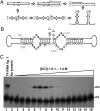Viroid RNA redirects host DNA ligase 1 to act as an RNA ligase
- PMID: 22869737
- PMCID: PMC3427106
- DOI: 10.1073/pnas.1206187109
Viroid RNA redirects host DNA ligase 1 to act as an RNA ligase
Abstract
Viroids are a unique class of noncoding RNAs: composed of only a circular, single-stranded molecule of 246-401 nt, they manage to replicate, move, circumvent host defenses, and frequently induce disease in higher plants. Viroids replicate through an RNA-to-RNA rolling-circle mechanism consisting of transcription of oligomeric viroid RNA intermediates, cleavage to unit-length strands, and circularization. Though the host RNA polymerase II (redirected to accept RNA templates) mediates RNA synthesis and a type-III RNase presumably cleavage of Potato spindle tuber viroid (PSTVd) and closely related members of the family Pospiviroidae, the host enzyme catalyzing the final circularization step, has remained elusive. In this study we propose that PSTVd subverts host DNA ligase 1, converting it to an RNA ligase, for the final step. To support this hypothesis, we show that the tomato (Solanum lycopersicum L.) DNA ligase 1 specifically and efficiently catalyzes circularization of the genuine PSTVd monomeric linear replication intermediate opened at position G95-G96 and containing 5'-phosphomonoester and 3'-hydroxyl terminal groups. Moreover, we also show a decreased PSTVd accumulation and a reduced ratio of monomeric circular to total monomeric PSTVd forms in Nicotiana benthamiana Domin plants in which the endogenous DNA ligase 1 was silenced. Thus, in a remarkable example of parasitic strategy, viroids reprogram for their replication the template and substrate specificity of a DNA-dependent RNA polymerase and a DNA ligase to act as RNA-dependent RNA polymerase and RNA ligase, respectively.
Conflict of interest statement
The authors declare no conflict of interest.
Figures




Similar articles
-
Involvement of the chloroplastic isoform of tRNA ligase in the replication of viroids belonging to the family Avsunviroidae.J Virol. 2012 Aug;86(15):8269-76. doi: 10.1128/JVI.00629-12. Epub 2012 May 23. J Virol. 2012. PMID: 22623792 Free PMC article.
-
Monomeric linear RNA of citrus exocortis viroid resulting from processing in vivo has 5'-phosphomonoester and 3'-hydroxyl termini: implications for the RNase and RNA ligase involved in replication.J Virol. 2008 Oct;82(20):10321-5. doi: 10.1128/JVI.01229-08. Epub 2008 Aug 13. J Virol. 2008. PMID: 18701598 Free PMC article.
-
DNA Ligase I Circularises Potato Spindle Tuber Viroid RNA in a Biomolecular Condensate.Mol Plant Pathol. 2024 Dec;25(12):e70047. doi: 10.1111/mpp.70047. Mol Plant Pathol. 2024. PMID: 39715063 Free PMC article.
-
Viroids: the minimal non-coding RNAs with autonomous replication.FEBS Lett. 2004 Jun 1;567(1):42-8. doi: 10.1016/j.febslet.2004.03.118. FEBS Lett. 2004. PMID: 15165891 Review.
-
Viroids and viroid-host interactions.Annu Rev Phytopathol. 2005;43:117-39. doi: 10.1146/annurev.phyto.43.040204.140243. Annu Rev Phytopathol. 2005. PMID: 16078879 Review.
Cited by
-
Dissecting the secondary structure of the circular RNA of a nuclear viroid in vivo: A "naked" rod-like conformation similar but not identical to that observed in vitro.RNA Biol. 2017 Aug 3;14(8):1046-1054. doi: 10.1080/15476286.2016.1223005. Epub 2016 Aug 30. RNA Biol. 2017. PMID: 27574720 Free PMC article.
-
A scenario for the emergence of protoviroids in the RNA world and for their further evolution into viroids and viroid-like RNAs by modular recombinations and mutations.Virus Evol. 2022 Jan 15;8(1):veab107. doi: 10.1093/ve/veab107. eCollection 2022. Virus Evol. 2022. PMID: 35223083 Free PMC article. Review.
-
Viroid research and its significance for RNA technology and basic biochemistry.Nucleic Acids Res. 2018 Nov 16;46(20):10563-10576. doi: 10.1093/nar/gky903. Nucleic Acids Res. 2018. PMID: 30304486 Free PMC article. Review.
-
Viroids, and the Legacy of Ricardo Flores (1947-2020).Cells. 2021 Sep 28;10(10):2570. doi: 10.3390/cells10102570. Cells. 2021. PMID: 34685550 Free PMC article.
-
Novel approaches for efficient in vivo fermentation production of noncoding RNAs.Appl Microbiol Biotechnol. 2020 Mar;104(5):1927-1937. doi: 10.1007/s00253-020-10350-3. Epub 2020 Jan 17. Appl Microbiol Biotechnol. 2020. PMID: 31953559 Free PMC article. Review.
References
-
- Diener TO, Raymer WB. Potato spindle tuber virus: A plant virus with properties of a free nucleic acid. Science. 1967;158:378–381. - PubMed
-
- Gross HJ, et al. Nucleotide sequence and secondary structure of potato spindle tuber viroid. Nature. 1978;273:203–208. - PubMed
-
- Semancik JS, Weathers LG. Exocortis virus of citrus: Association of infectivity with nucleic acid preparations. Virology. 1968;36:326–328. - PubMed
-
- Flores R, Hernández C, Martínez de Alba AE, Daròs JA, Di Serio F. Viroids and viroid-host interactions. Annu Rev Phytopathol. 2005;43:117–139. - PubMed
-
- Ding B. The biology of viroid-host interactions. Annu Rev Phytopathol. 2009;47:105–131. - PubMed
Publication types
MeSH terms
Substances
LinkOut - more resources
Full Text Sources
Other Literature Sources
Research Materials

